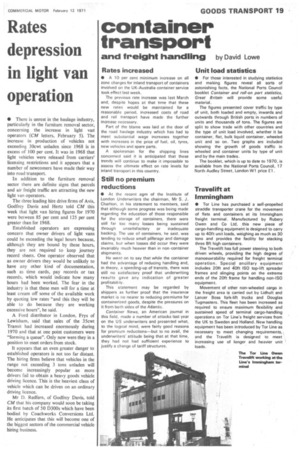container transport
Page 21

If you've noticed an error in this article please click here to report it so we can fix it.
and freight handling by David Lowe
Rates increased
• A 10 per cent minimum increase on all zone charges for inland transport of containers involved on the UK-Australia container service took effect last week.
The previous rate increase was last March and, despite hopes at that time that these new rates would be maintained for a reasonable period, increased costs of road and rail transport have made the further increase necessary.
Part of the blame was laid at the door of the road haulage industry which has had to meet substantial wage increases together with increases in the price of fuel, oil, tyres, new vehicles and spare parts.
A spokesman for the shipping lines concerned said it is anticipated that these trends will continue to make it impossible to assess the ultimate effect on rate levels for inland transport in this country.
Still no premium reductions
• At the recent agm of the Institute of London Underwriters the chairman, Mr S. J. Charlton, in his statement to members, said that although some progress was being made regarding the education of those responsible for the storage of containers, there were still far too many losses being sustained through unsatisfactory or inadequate backing. The use of containers, he said, was tending to reduce small pilferage and damage claims, but when losses did occur they were invariably much heavier than in non-container shipments.
He went on to say that while the container had the advantage of reducing handling and, in theory, a speeding-up of transits, there was still no satisfactory proof that underwriting results gave any indication of greater profitability.
This statement may be regarded by shippers as further proof that the insurance market is no nearer to reducing premiums for containerized goods, despite the pressures on it from both sides of the Atlantic.
Container News, an American journal in this field, made a number of attacks last year on the US underwriters and presented what, to the logical mind, were fairly good reasons for premium reductions—but to no avail, the underwriters' attitude being that at that time, they had not had sufficient experience to justify a change of tariff structures.
Unit load statistics
• For those interested in studying statistics and making figures reveal all sorts of astonishing facts, the National Ports Council booklet Container and roll-on port statistics, Great Britain will provide some useful material.
The figures presented cover traffic by type of unit, both loaded and empty, inwards and outwards through British ports in numbers of units and thousands of tons. The figures are split to show trade with other countries and the type of unit load involved, whether it be container, flat, bulk liquid container, wheeled unit and so on. Two graphs are included showing the growth of goods traffic in wheeled and container units by type of unit and by the main trades.
The booklet, which is up to date to 1970, is available from the National Ports Council, 17 North Audley Street, London W1 price £1.
Travelift at Immingham
• Tor Line has purchased a self-propelled straddle transporter crane for the movement of flats and containers at its Immingham freight terminal. Manufactured by Rubery Owen and Co Ltd, this new piece of cargo-handling equipment is designed to carry up to 40ft unit loads, weighing as much as 30 tons and provides the facility for stacking three 8ft high containers.
The Travelift has full power steering to both driven wheels, providing the high degree of manoeuvrability required for freight terminal operation. Special ancillary equipment includes 2Oft and 40ft ISO top-lift spreader frames and slinging points on the extreme ends of the 20ft frame for handling non-ISO equipment.
Movement of other non-wheeled cargo in the freight area is carried out by Lidhult and Lancer Boss fork-lift trucks and Douglas Tugmasters. This fleet has been increased as required to ensure maximum flexibility and sustained speed of terminal cargo-handling operations on Tor Line's freight services from the UK to Sweden and Holland. New handling equipment has been introduced by Tor Line as necessary to meet changing requirements,.. and the Travelift is designed to meet increasing use of longer and heavier unit ' loads.
































































































